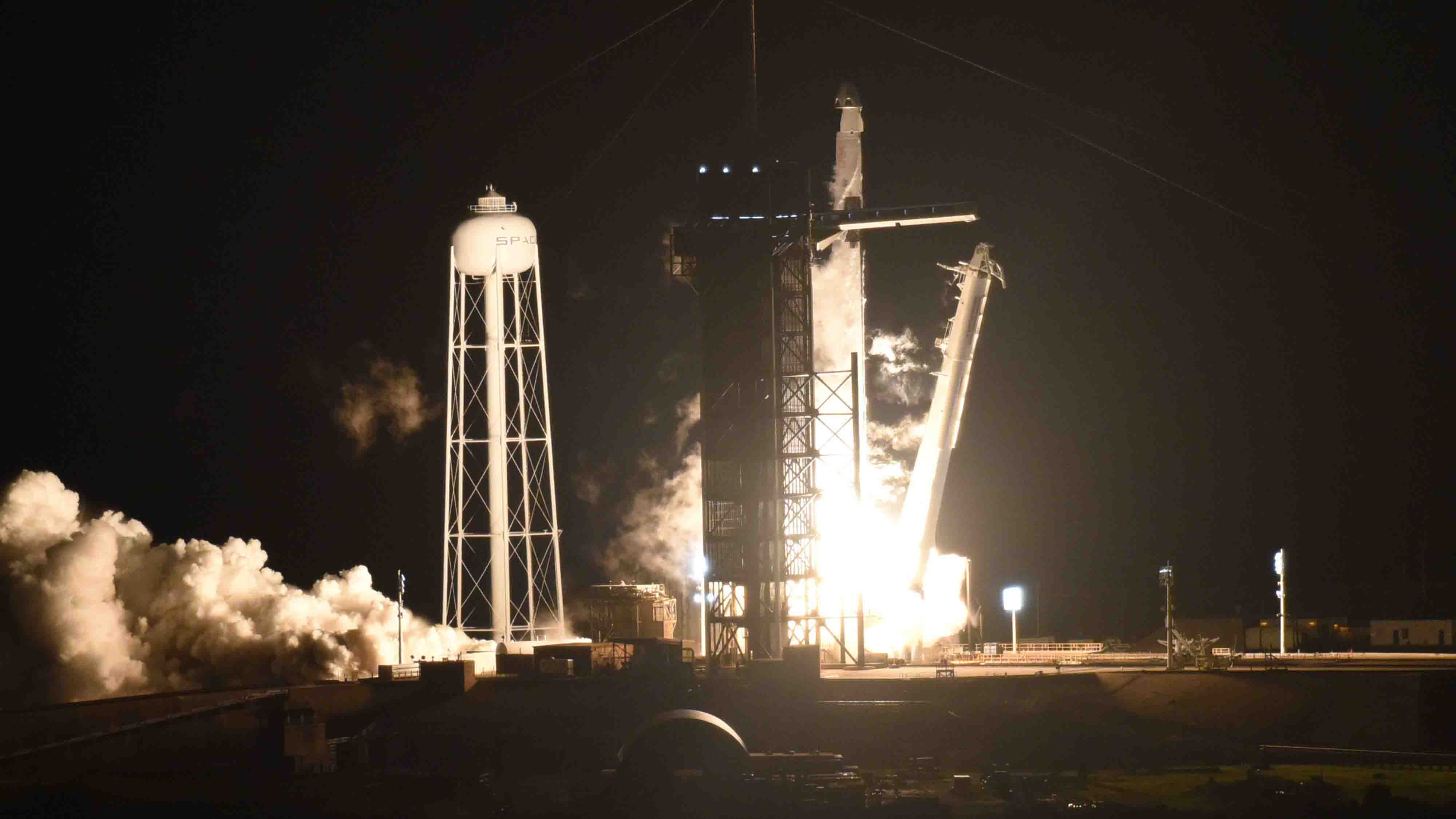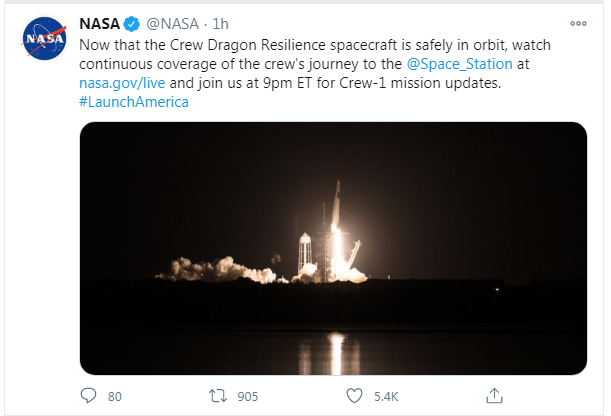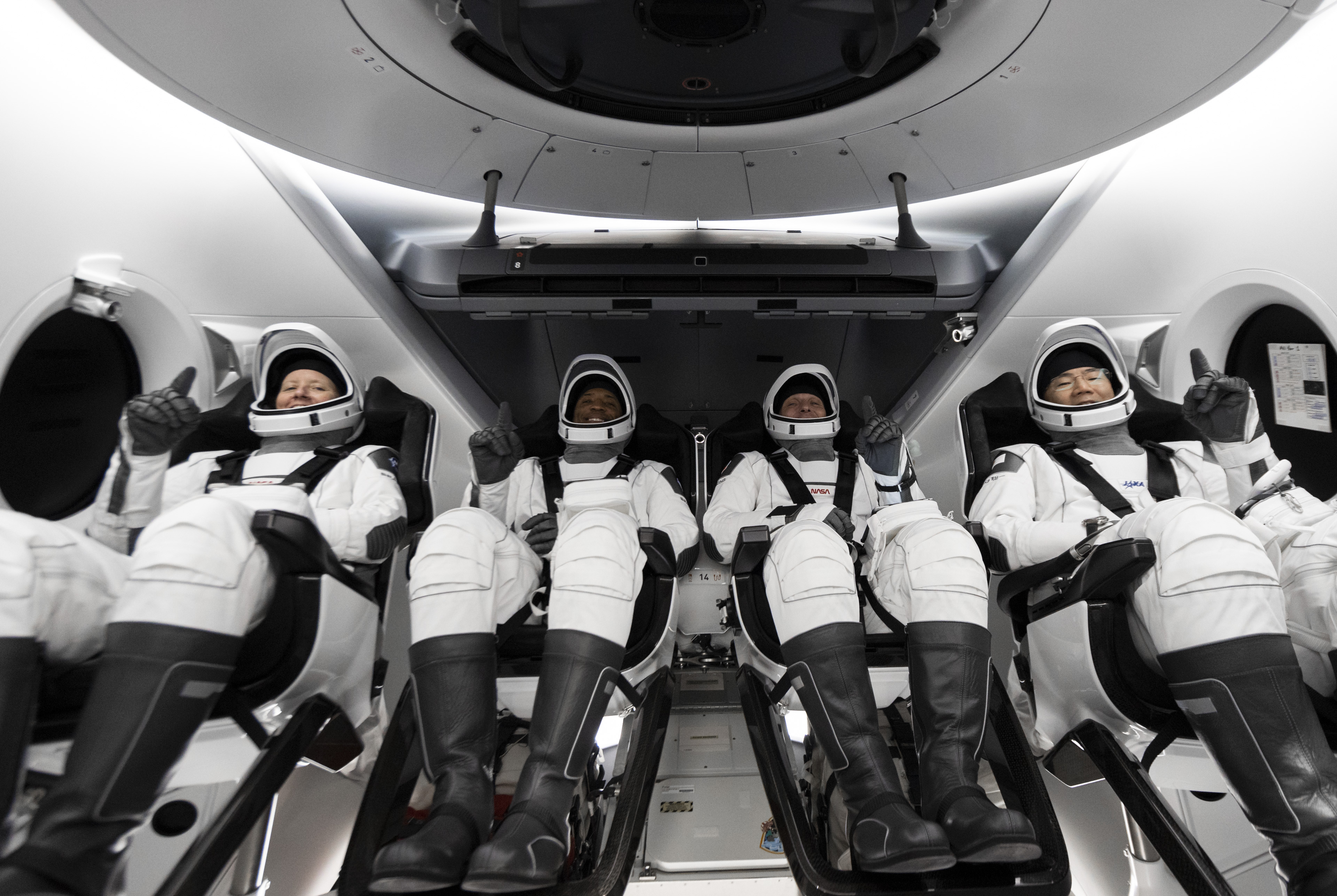01:04

SpaceX on Sunday launched four astronauts on a flight to the International Space Station (ISS), NASA's first full-fledged mission sending a crew into orbit aboard a privately-developed spacecraft.
The newly-designed Crew Dragon capsule, with three Americans and one Japanese onboard, lifted off atop a SpaceX Falcon 9 rocket from NASA's Kennedy Space Center in Cape Canaveral, Florida.
The Dragon capsule, named Resilience by its crew in light of the severe challenges the world experienced this year, most notably COVID-19 – was due to reach the space station late Monday and remain there for six months until spring.

Screenshot from NASA's Twitter.
Screenshot from NASA's Twitter.
Cheers and applause erupted at SpaceX Mission Control in Hawthorne, California, after the capsule reached orbit and the first-stage booster landed on a floating platform in the Atlantic.
Sidelined by the virus himself, SpaceX founder and CEO Elon Musk was forced to monitor the action from afar. He tweeted that he "most likely" had a moderate case of COVID-19. NASA policy at Kennedy Space Center requires anyone testing positive for coronavirus to quarantine and remain isolated.
Sunday's launch follows by just a few months SpaceX's two-pilot test flight. It kicks off what NASA hopes will be a long series of crew rotations between the U.S. and the space station, after years of delay. More people means more science research at the orbiting lab, according to officials.
"This is another historic moment," NASA Administrator Jim Bridenstine said Friday. But he noted: "Make no mistake: Vigilance is always required on every flight."
The flight to the space station – 27 1/2 hours door to door – should be entirely automated, although the crew can take control if needed.
Who are the astronauts onboard?
— Crew commander Mike Hopkins, 51, is an Air Force colonel and former space station resident who grew up on a hog and cattle farm in Missouri. He was working as a special assistant to the vice chairman of the Joints Chief of Staff when he got the call from NASA.
—Navy Commander Victor Glover, 44, is the pilot and lone space rookie. He's from the Los Angeles area and will be the first African-American astronaut to move into the space station for a long stay. When picked as a NASA astronaut in 2013, he was working as a legislative fellow for the late Senator John McCain.
—Shannon Walker, 55, a Houston-born-and-raised physicist, also has lived before on the space station. Her husband, retired astronaut Andrew Thomas, helped build the outpost. She worked as a flight controller at NASA's Johnson Space Center and then behind the scenes in the space station program, before becoming an astronaut in 2004.
—The Japanese Space Agency's Soichi Noguchi, 55, another former station resident, is only the third person to launch on three types of spacecraft. (He follows the late Wally Schirra and John Young) He's already flown on a U.S. space shuttle — the first mission after the 2003 Columbia accident — and a Russian Soyuz.
They rode out to the launch pad in Teslas – another Musk company product – after exchanging high-fives and embraces with their children and spouses, who huddled at the open car windows. Musk was replaced by SpaceX President Gwynne Shotwell in bidding the astronauts farewell.

NASA astronauts, from left, Shannon Walker, Victor Glover, and Michael Hopkins and Japan Aerospace Exploration Agency astronaut Soichi Noguchi leave the Operations and Checkout Building on their way to launch pad 39A for the SpaceX Crew-1 mission to the International Space Station at the Kennedy Space Center in Cape Canaveral, Florida, Nov. 15, 2020. /AP
NASA astronauts, from left, Shannon Walker, Victor Glover, and Michael Hopkins and Japan Aerospace Exploration Agency astronaut Soichi Noguchi leave the Operations and Checkout Building on their way to launch pad 39A for the SpaceX Crew-1 mission to the International Space Station at the Kennedy Space Center in Cape Canaveral, Florida, Nov. 15, 2020. /AP
Launch amid COVID-19
With COVID-19 still surging, NASA continued the safety precautions put in place for SpaceX's crew launch in May. The astronauts went into quarantine with their families in October. All launch personnel wore masks, and the number of guests at Kennedy Space Center was limited. Even the two astronauts on the first SpaceX crew flight stayed behind at Johnson Space Center in Houston.
Vice President Mike Pence, chairman of the National Space Council, traveled from Washington to watch the launch.
"I didn't start breathing until about a minute after it took off," Pence said during a stop at SpaceX Launch Control to congratulate the workers.
Outside the space center gates, spectators crowded into nearby beaches and towns.
NASA worried a weekend liftoff – coupled with a dramatic nighttime launch – could lead to a superspreader event. They urged the crowds to wear masks and maintain safe distances. Similar pleas for SpaceX's first crew launch on May 30 went unheeded.
"In such a crazy year, we have finally some great news," said Sophia Giallanza, who came from Miami with her husband and son to see their first launch. "So it's really wonderful."

The four astronauts inside the Dragon capsule, ready for the launch./NASA
The four astronauts inside the Dragon capsule, ready for the launch./NASA
Besides its sleek design and high-tech features, the Dragon capsule is quite spacious – it can carry up to seven people. Previous space capsules have launched with no more than three. The extra room in the capsule was used for science experiments and supplies.
The four astronauts will be joining two Russians and one American who flew to the space station last month from Kazakhstan.
The first-stage booster – aiming for an ocean platform several minutes after liftoff – is expected to be recycled by SpaceX for the next crew launch. That's currently targeted for the end of March, which would set up the newly launched astronauts for a return to Earth in April. SpaceX would launch yet another crew in late summer or early fall.
In the next 15 months, SpaceX should be flying roughly seven Dragon missions for NASA, both crew and cargo, Shotwell said.
SpaceX and NASA wanted the booster recovered so badly that they delayed the launch attempt by a day, to give the floating platform time to reach its position in the Atlantic over the weekend following rough seas.
NASA turned to private companies to haul cargo and crew to the space station, after the shuttle fleet retired in 2011. SpaceX qualified for both. With Kennedy back in astronaut-launching action, NASA can stop buying seats on Russian Soyuz rockets. The last one cost $90 million.
The commander of SpaceX's first crew, Doug Hurley, noted it's not just about saving money or easing the training burdens for crews.
"Bottom line: I think it's just better for us to be flying from the United States if we can do that," he said last week.
(With input from AP.)

